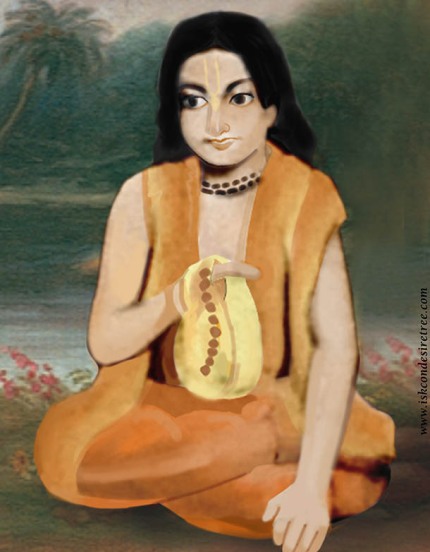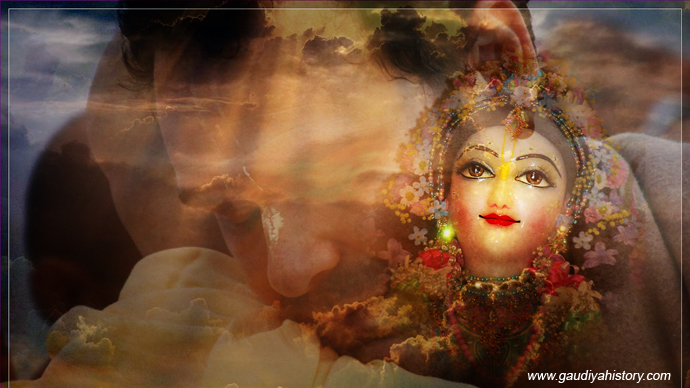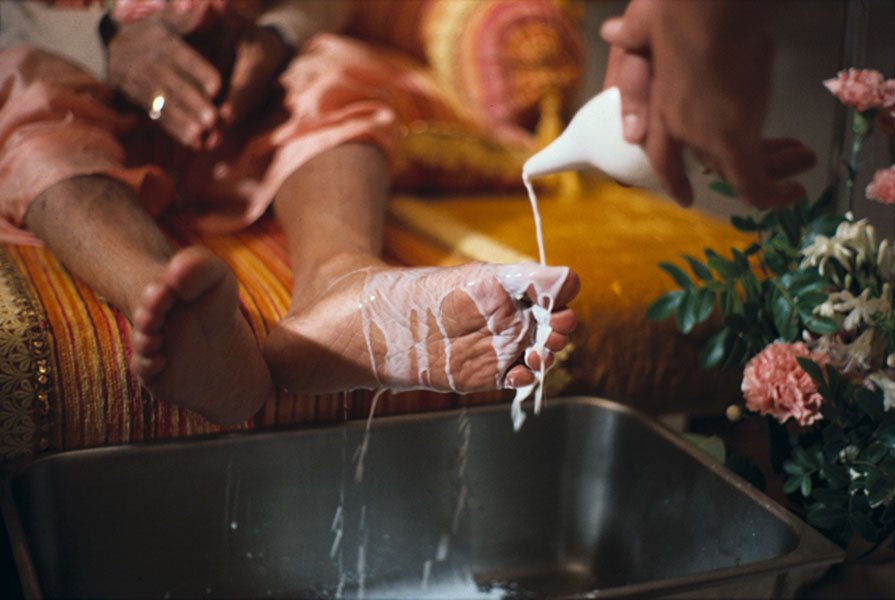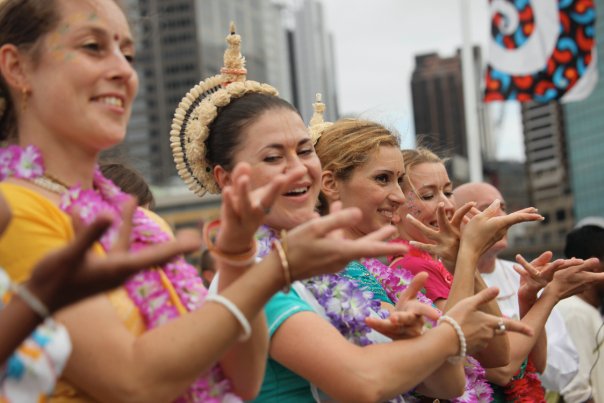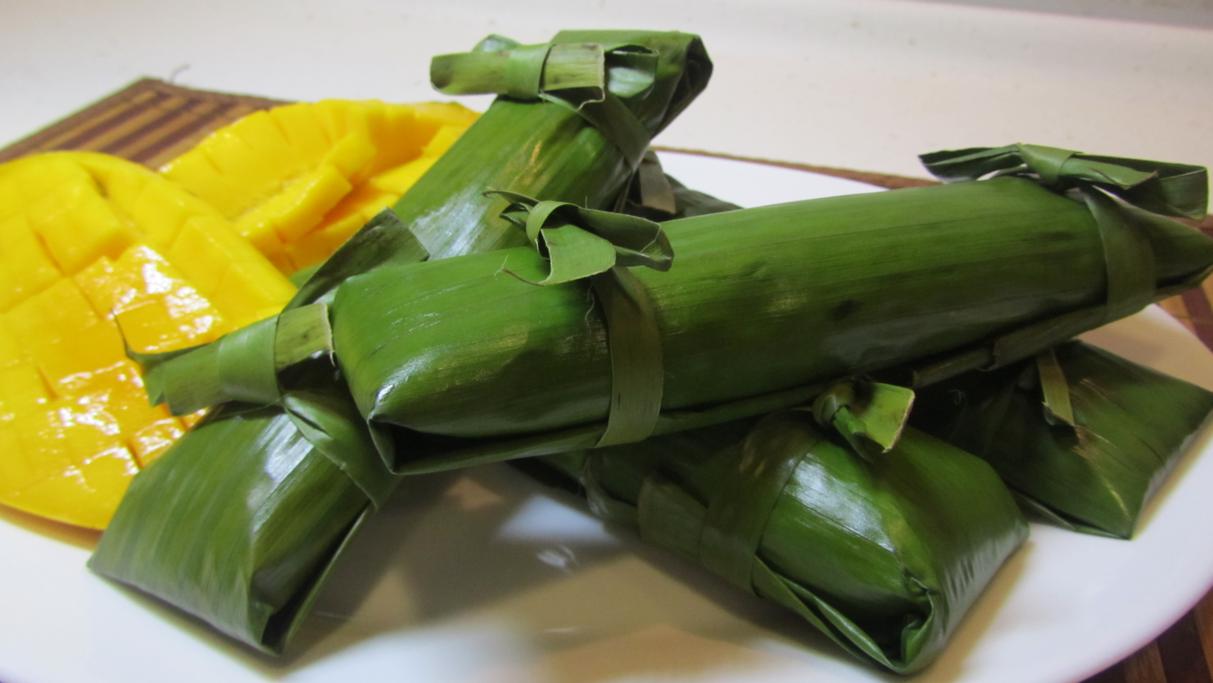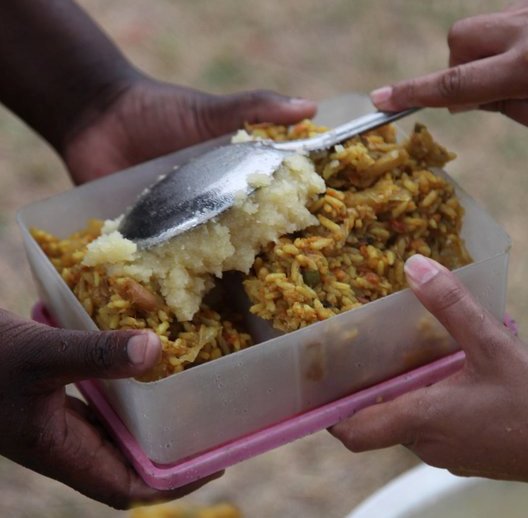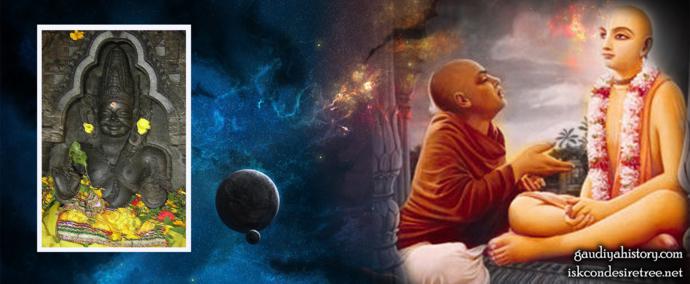
Sarvabhauma Bhattacharya was formerly Brihaspati, the guru of the gods. (Gaura-ganoddesha-dipika 119) (In the wallpaper: from left to right Deity of Brihastpati, Sun Temple - Konark, Orissa, Sarvabhauma Bhattacharya, Lord Shri Chaitanya).
Sarvabhauma Bhattacharya was formerly Brihaspati, the guru of the gods. (Gaura-ganoddesha-dipika 119)
Sarvabhauma’s Scholarship
When Krishnadas Kaviraj Goswami lists the branches of Shri Chaitanya, after listing those Devotees like Paramananda Puri and Svarupa Damodar who came to join the Lord in Jagannath Puri, he enumerates those Bengali Devotees who were already living in Puri when the Lord arrived there and who then met him for the very first time. Sarvabhauma Bhattacharya is considered the most important of these Devotees.
One of the biggest branches of the Lord was Sarvabhauma Bhattacharya. Another was his brother-in-law, Gopinath Acharya. (Chaitanya Charitamrita 1.10.130)
Shrila Bhaktisiddhanta Saraswati Goswami Thakur’s has commented on this Bengali verse as follows: "Sarvabhauma Bhattacharya’s given name was Vasudeva. He was the son of Maheshvara Visharada, a celebrated resident of Vidyanagara, a village which lies about two and a half miles away from both Navadwip and Champahati. Sarvabhauma Bhattacharya was a student of Pakshadhara Mishra, the head professor of what was at that time India’s leading school of logic (nyaya) in Mithila in Bihar. Sarvabhauma Bhattacharya memorized the entire body of learning available there and then returned to Navadwip to establish his own school for the study of logic. This caused a revolution in the history of this branch of learning, as the importance of Mithila was diminished to the profit of Navadwip, which to this day still has the reputation of being the leading centre of nyaya studies. According to some, the celebrated logician Raghunath Shiromani, author of the work Didhiti, studied under Sarvabhauma Bhattacharya. Whatever the truth of such statements, it is clear that Sarvabhauma Bhattacharya had tremendous learning in both Nyaya and Vedanta. Although he was a grihastha, he took the kshetra-sannyasa, vowing never to set foot outside of Jagannath Puri, and he taught Vedanta to students there. He gave discourses on Shankaracharya’s commentary on the Vedanta to Mahaprabhu Himself until he came to understand its real meaning by His grace."
Sarvabhauma Bhattacharya was an aristocratic Brahmin of the Rarha class. From the Gaudiya Vaishnava Abhidhana, we learn that he took his birth in the first half of the 14th century of the Shaka era. We also learn there that when he studied in Mithila, the nyaya scholars of that city attempted to maintain their monopoly on teaching this branch of philosophy by prohibiting their foreign students from copying the textbooks. For this reason it was impossible to either teach or study logic in Bengal at that time. Vasudeva Bhattacharya was endowed with marvelous powers of retention and he was thus able to memorize all the texts that he had studied in Mithila. When he returned to Bengal, he was thus able to transcribe these texts and make them readily available to his students. The scholar Dr. Dinesh Chandra Bhattacharya has argued that this is mere legend, however. He says that in fact Vasudeva Sarvabhauma learned the Navya-nyaya ("new logical method") from his father, Visharada, and never went to Mithila. When Maharaj Prataparudra heard of his tremendous learning, he invited him to come to Puri and to become the chief scholar of his court.
Sarvabhauma, the Teacher of Mayavada
Even though he was a householder, Sarvabhauma Bhattacharya was so highly qualified that he became the teacher even of many sannyasis of the impersonalist school. In fact, the guru of the gods, Brihaspati, took birth as Sarvabhauma Bhattacharya in order to support Mahaprabhu’s pastime of delivering the Mayavadis. Little wonder, then, that he was an incomparable scholar!
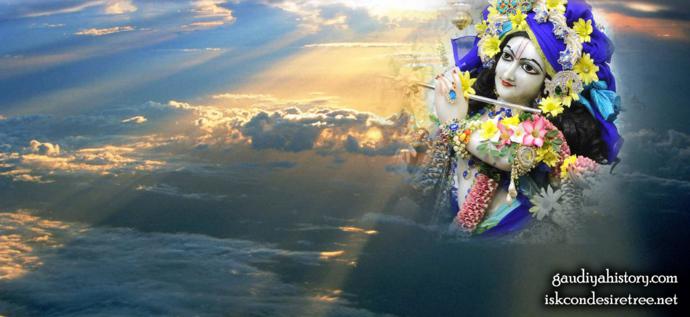
According to the pure and true doctrines of Vaishnavism, the Supreme Lord, who is the object of worship, possesses an eternal identity and His name, form, qualities and pastimes are all eternal and spiritual in nature. The Mayavadis who follow the path of knowledge deny the eternal spiritual character of the Lord’s essence, name, form, qualities and pastimes. They hold that these are a products of the illusory energy. This is the source of the title "mayavada", which means "illusory" (maya) , "form" (rupa), "doctrine" (vada). The Mayavadis hold that the form of the Lord is a fabrication that is only useful as a meditation aid for less advanced spiritual practitioners. They hold that Brahma, the formless, undifferentiated and potency-less form is the supreme truth. Nothing exists outside of this Brahman and thus the individual living being is identical with it. (In the wallpaper: Shri Gopinath, ISKCON Chowpatty, Mumbai).
Shri Chaitanya Mahaprabhu and all the Vaishnava acharyas have accepted as dogmatic truth that the object of worship (bhajaniya), the worshiper (bhajana-kari) and the act of worship (bhajana) are all eternal principles. Pure devotional service cannot be present if the eternal existence of any one of these three principles is denied. According to the pure and true doctrines of Vaishnavism, the Supreme Lord, who is the object of worship, possesses an eternal identity and His name, form, qualities and pastimes are all eternal and spiritual in nature. The Mayavadis who follow the path of knowledge deny the eternal spiritual character of the Lord’s essence, name, form, qualities and pastimes. They hold that these are a products of the illusory energy. This is the source of the title "mayavada", which means "illusory" (maya) , "form" (rupa), "doctrine" (vada). The Mayavadis hold that the form of the Lord is a fabrication that is only useful as a meditation aid for less advanced spiritual practitioners. They hold that Brahma, the formless, undifferentiated and potency-less form is the supreme truth. Nothing exists outside of this Brahman and thus the individual living being is identical with it.
The Mayavadis hold that devotional practice has a momentary value for the less advanced spiritual practitioners which helps them to attain the state of identification with Brahman, at which time it can be discarded as it has no status in the eternal truth. It is clear, then, that such a doctrine interferes with the attainment of the fifth and ultimate goal of life, love of God. The founders of the four schools of Vaishnava thought, Madhvacharya, Ramanujacharya, Vishnuswami and Nimbarka, as well as the Supreme Lord, Shri Chaitanya Mahaprabhu Himself, have thus fought against the Mayavadi teachings of Shankaracharya characterized by the vivarta-vada or "doctrine of the apparent transformation of Brahman". Those who seek their ultimate benefit accept the teaching given by Vedavyasa himself, known as shakti-parinama-vada ("the doctrine of the transformation of the energies of Brahman").
Shri Chaitanya Mahaprabhu appeared in this most fortunate age of Kali in order to bestow the most elevated service to Krishna in the conjugal mood upon everyone, whether low or high-born. He gave the supreme gift of love for God without judging the qualifications of the recipient. Furthermore, He became incarnate with intention of destroying the desires which lead the living being away from the Lord and interfere with His attainment of love; He also bestowed upon them the desire for this love and the power through which it can be established in their hearts. Even with all this mercy, the Mayavadi doctrine remains the biggest obstacle to attaining love for Krishna.

Shri Chaitanya Mahaprabhu appeared in this most fortunate age of Kali in order to bestow the most elevated service to Krishna in the conjugal mood upon everyone, whether low or high-born. He gave the supreme gift of love for God without judging the qualifications of the recipient. Furthermore, He became incarnate with intention of destroying the desires which lead the living being away from the Lord and interfere with His attainment of love; He also bestowed upon them the desire for this love and the power through which it can be established in their hearts. Even with all this mercy, the Mayavadi doctrine remains the biggest obstacle to attaining love for Krishna. (In the wallpaper: Shri Jaya Gauranga, ISKCON Hungary, New Vraja dham, Devotees doing sankirtana yagya, Shri Vrindavan dham, Uttar Pradesh).
Mahaprabhu delivered the Mayavadi Sarvabhauma Bhattacharya. Both Vrindavan Das Thakur, not different from Vedavyasa himself, and Krishnadas Kaviraj Goswami have described how this took place in their biographies of the Lord. The essence of the accounts of the Chaitanya Bhagavat and Chaitanya Charitamrita are given below.
Sarvabhauma Takes the Lord to His House
At the age of 24, Mahaprabhu left Navadwip to take sannyasa from Keshava Bharati in Katwa. From there He went to Shantipur and then on to Puri. When He arrived at Atharo Nala, a bridge with eighteen arches which marks the entrance to the town of Jagannath Puri, the Lord saw the Temple spire and had a vision of Krishna. He ran toward the Temple in a trance of love and when He entered, ran towards the Deity of Jagannath in order to embrace Him. As He came close to the altar, He fell down in a faint. The Temple watchmen and sevayats saw Him lying unconscious in the Temple, and thinking Him to be a vagrant, prepared to beat and evict Him from the Temple.
Vasudeva Sarvabhauma happened to be there and he stopped them from so doing. He had been impressed by the beauty of the Lord as well as by the manifestations of spiritual ecstasy at the sight of Lord Jagannath. He could understand that this was no ordinary person. With the help of his disciples and the Temple guards, Vasudeva Sarvabhauma had the unconscious Lord transported to his own home. He was quite anxious about the Lord’s condition and placed a tuft of cotton before His nose to see if He was still breathing. He was relieved to see saw the cotton move slightly.
In the meantime, Nityananda Prabhu, Mukunda Datta, Jagadananda Pandit and Damodar Pandit arrived at the Lion’s Gate entrance to the Temple and heard from other visitors to the Temple that Mahaprabhu had been removed and taken to Sarvabhauma Bhattacharya’s house. Simultaneously, Sarvabhauma’s brother-in-law, Gopinath Acharya, passed by there. Since he too was from Navadwip, the Lord’s Devotees recognized Him. Mukunda told him everything about Mahaprabhu’s sannyasa and his coming to Puri, as well as about his being taken to Sarvabhauma’s house. Gopinath was thrilled to hear all this news and he took them to his brother-in-law’s house.
The Devotees were relieved and overjoyed to see the Lord there. Sarvabhauma paid his obeisances to Nityananda Prabhu and then told them to go and take darshan of Jagannath Deva, sending his son Chandaneshvara to accompany them as their guide. When they had returned, they began to sing the Holy Names aloud and this brought Mahaprabhu back to consciousness. In his paternal affection for the Lord, he prohibited Him from going to the Temple alone. He invited the Lord and His companions for lunch and sent them to take bath in the ocean. When they returned he fed them to their full satisfaction with varieties of Jagannath’s Maha Prasada.
When Sarvabhauma learned of Mahaprabhu’s family background, he was very happy, for his father Maheshvara Visharada had been a good friend of Mahaprabhu’s maternal grandfather, Nilambara Chakravarti. Sarvabhauma himself was much older than the Lord and so he felt protective toward Him. He said, "The name Krishna Chaitanya which You have been given is a very good name. But You have been initiated into the Bharati line of sannyasis, which has only a moderately good reputation. I can get You reinitiation in a more prestigious line if You wish."
Gopinath and the other Devotees were disappointed to hear Sarvabhauma make this suggestion. Gopinath objected, "Shri Chaitanya Mahaprabhu is the Supreme Lord Himself. He does not depend on any external formalities." Sarvabhauma and his disciples debated these points with Gopinath at some length, and this has been described by Krishnadas Kaviraj Goswami in the sixth chapter of the Chaitanya Charitamrita’s Madhya-lila.
Mahaprabhu Himself asked the Devotees not to argue with Sarvabhauma Bhattacharya because he was the Lord’s senior and was only advising him out of affection for him. How could they object to this? The Lord, setting the example of one who is free from any hankering after prestige and who is ready to give all respect to others, indicated that He was willing to hear Sarvabhauma’s advice.
Sarvabhauma Bhattacharya then said to the Lord that He was a handsome young man and that if He wanted to maintain his sannyasa vows, he should study Vedanta diligently. This would awaken the required attitude of renunciation from the world in Him. The Lord accepted his invitation to learn from him and for the next seven days He took instruction from him instructing in Vedanta. When Sarvabhauma saw that Mahaprabhu was not asking any questions, but simply listening silently, he said, "The study of Vedanta is demanding. A student who wishes to understand the material properly is generally obliged to ask questions to clarify difficult areas."
The Lord answered, "You told Me to listen, not to ask questions. So I have been listening. I find no difficulty understanding the meaning of the sutras for they are as self-evident as the sun. On the other hand, your explanations are confusing. I find them to hide the clear meaning of the sutras just like clouds covering the sun."
Sarvabhauma Bhattacharya felt slighted by the Lord’s comments and indeed felt somewhat angry. He started to debate the meaning of the word "Brahman" with the Lord. Sarvabhauma established that Brahman was without form or qualities, having recourse to various scriptures as evidence. The Lord showed with logic and scriptural references that Brahman possessed form and qualites. The Lord cited the atmarama verse from the Bhagavat and asked Sarvabhauma to explain it.
atmaramash ca munayo nirgrantha apy urukrame kurvanty ahaitukim bhaktim itthambhuta-guno harih
Even those silent sages who are fully self-satisfied and freed from bondage perform causeless devotional service to Lord Hari, whose pastimes are wonderful, for such is the glorious nature of His qualities. (SB 1.7.10)
After Vasudeva Sarvabhauma had given nine different explanations of the verse, Mahaprabhu put on a display of superhuman scholarship by explaining the same verse in eighteen ways without even touching on those meanings given by Sarvabhauma. The scholar was astounded and speechless. He began slowly to understand that Mahaprabhu was not an ordinary human being, but the Supreme Lord Himself. He started to regret his arrogance and finally fell down at the Lord’s feet and begged Him for forgiveness.
Sarvabhauma Becomes the Lord’s Devotee
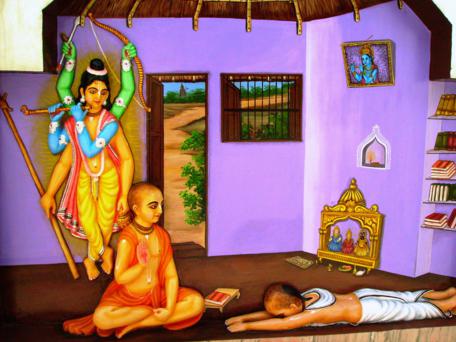
When Sarvabhauma saw the six-armed form of the Lord, as brilliant as a million suns, he fell down in a faint. (Chaitanya Bhagavat 3.3.107) (In the wallpaper: Sadbhuja form of the Lord, Shri Chaitanya Mahaprabhu, Sarvabhama Bhattacharya).
The Lord in His kindness displayed a number of different divine forms to Sarvabhauma, starting with a four-armed Narayan form, then a two-armed Krishna form, holding a flute, and finally a six-armed form.
When Sarvabhauma saw the six-armed form of the Lord, as brilliant as a million suns, he fell down in a faint. (Chaitanya Bhagavat 3.3.107)
After seeing these divine manifestations, Sarvabhauma Bhattacharya wrote a panegyric of the Lord in a hundred Sanskrit verses. He wrote two of these verses down on a palm leaf and sent them to Mahaprabhu through Jagadananda Pandit. Jagadananda took the precaution of writing the verses down on the doorway before showing them to the Lord, and as a result of this foresight the verses were preserved, for Mahaprabhu tore the palm leaves up as soon as He saw them. The Devotees saw the verses written on the doorframe and memorized them:
vairagya-vidya-nija-bhakti-yoga-shikshartham ekah purushah puranah shri-krishna-
caitanya-sharira-dhari kripambudhir yas tam aham prapadye
Let me take shelter of the Supreme Personality of Godhead, the ocean of transcendental mercy, Shri Krishna, who has descended in the form of Lord Chaitanya Mahaprabhu to teach us detachment, real knowledge and His own devotional service.
kalan nashtam bhakti-yogam nijam yah pradushkartum krishna-caitanya-nama avirbhutas
tasya padaravinde gadham gadham liyate citta-bhringah
The Supreme Personality of Godhead, who has taken the name of Shri Krishna Chaitanya, has appeared to reveal the ancient system of devotional service to Himself which had almost been lost due to the influence of time. I pray that the honeybee of my mind will drink deeply of the nectar of His lotus feet. (Chaitanya Charitamrita 2.6.253-4; Chaitanya-chandrodaya-nataka 6.74)
A Deity of Mahaprabhu’s six-armed form is still worshipped today in the Jagannath Temple at Puri.
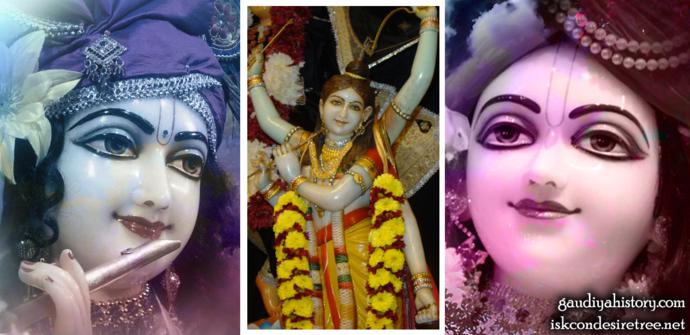
The Supreme Personality of Godhead, who has taken the name of Shri Krishna Chaitanya, has appeared to reveal the ancient system of devotional service to Himself which had almost been lost due to the influence of time. I pray that the honeybee of my mind will drink deeply of the nectar of His lotus feet. (Chaitanya Charitamrita 2.6.253-4; Chaitanya-chandrodaya-nataka 6.74) (In the wallpaper: in two sides Shri Krishna and Shri Gauranga Mahaprabhu, ISKCON Chennai, Sad Bhuja Deity of Sarvabhauma Bhattacharya).
Sarvabhauma’s Faith in Maha Prasada
One day not long afterward, Mahaprabhu came to Sarvabhauma’s house with Jagannath’s Maha Prasada and offered it to him. Sarvabhauma had not yet bathed, cleaned his teeth or performed his morning rituals. Despite his ritually impure state, he joyfully honored the Prasad, quoting a verse from the Padma-purana:
shushkam paryushitam vapi nitam va dura-deshatah prapti-matrena bhoktavyam natra kala-vicarana
One should honor Prasad as soon as one receives it, whether it is dried up, stale or brought from afar. In this, there should be no consideration of time or circumstances. (Chaitanya Charitamrita 2.6.225)
Mahaprabhu was delighted to see that Sarvabhauma had developed faith in Maha Prasad and immediately started to dance in ecstasy. Sarvabhauma joined Him and the two danced madly, shedding tears and trembling in their divine joy. Mahaprabhu said,
"Today I have been transported beyond the three worlds and have been taken to Vaikuntha. All My desires have been fulfilled simply because Sarvabhauma Bhattacharya has developed faith in Maha Prasad."
Sarvabhauma Changes the Words of the Bhagavat
Sarvabhauma’s attitude was so changed as a result of his conversion that one day, he recited a verse of the Shrimad Bhagavatam, but in which he had altered a word.
tat te 'nukampam su-samikshamano bhunjana evatma-kritam vipakam hrid-vag-vapurbhir
vidadhan namas te jiveta yo bhakti-pade sa daya-bhak
One who lives his life while joyfully seeing everything as your compassion even as he experiences the adverse conditions arising from his past deeds, and constantly pays obeisances to You with his mind, words and body, is certain to inherit a place at Your lotus feet, the object of all devotion. (SB 10.14.8)
Sarvabhauma had changed the word mukti-pade found in the original verse to bhakti-pade. Mahaprabhu explained that there was no need to change the words, in as much as mukti-pada ("the source of liberation") is an epithet of Krishna. Vasudeva answered, "You are quite correct to say that the words mukti-pade refer to Krishna, but the word mukti was used customarily in its sense of impersonal liberation, and thus did not bring as great a pleasure as the word bhakti". When the other scholars in Puri heard that Sarvabhauma Bhattacharya had been converted to devotion to Krishna, they all took shelter of Chaitanya Mahaprabhu.
Mahaprabhu Leaves for the South
Mahaprabhu took sannyas in the month of Magh and arrived in Puri in the month of Phalguna. He delivered Sarvabhauma Bhattacharya in the month of Chaitra and left for southern India in the month of Vaishakh. Nityananda Prabhu arranged for a certain Krishna Das Vipra to accompany Mahaprabhu as a servant. Before He left, Sarvabhauma gave the Lord a kaupina and bahirvasha and made a special request to the Lord to visit Ramananda Raya on the banks of the Godavari. At one time, Sarvabhauma had mocked Ramananda when he talked to him about devotional sentiment. Now, by the mercy of the Lord, he was able to recognize him for what he was, a highly advanced Devotee of Krishna. His words to the Lord were:
Ramananda Raya is the governor of Vidyanagara on the bank of the Godavari. It is my request that You meet him without fail. Please do not avoid him, thinking that he is a shudra who is only interested in material activities. If anyone is fit to associate with You, it is Ramananda Raya; in this world there is no devotee equal to him in the knowledge of the divine sentiments. He is not only a most learned scholar, but very knowledgeable in the science of sacred rapture. You will learn the extent of his glories by talking with him. When I first met Ramananda Raya, I could not understand what he was talking about, nor his activities, all of which are transcendental. So, I made fun of him because he is a Vaishnava. Now, by Your mercy, I am able to understand exactly how great he is. So too will you, once you converse with him. (Chaitanya Charitamrita 2.7.63-7)
Kashishvara and Govinda Come to Puri
After Ishvara Puripada’s disappearance, his two disciples and personal servants, Kashishvara and Govinda, came to Puri in order to serve Mahaprabhu as they had been told to do by their guru. When Sarvabhauma learned that Govinda was a shudra, he asked Mahaprabhu why his guru had taken a person of a lower caste as his personal servant. Mahaprabhu answered, "The Supreme Lord is completely autonomous and His mercy does not take anyone’s caste or creed into consideration. Service performed out of affection is thousands of times better than that which is performed out of a sense of duty or reverence. Krishna joyfully took His meal in the home of Vidura. However, as my guru’s personal servant, Govinda is an object of reverence and therefore it is improper for Me to accept service from him. On the other hand, My guru has ordered him to serve Me and I cannot ignore My spiritual master’s order. What do you think should I do?" Sarvabhauma responded to the Lord’s request for advice by saying, "One should never ignore the orders of the spiritual master. Scripture says that this is the supreme guiding principle."
Sarvabhauma Seeks an Audience for the King
While Mahaprabhu had been traveling through the South, Maharaj Prataparudra had heard a great deal about his glories from Sarvabhauma Bhattacharya. As a result, the King developed a desire to have an audience with the Lord, but Sarvabhauma warned him that the Lord was a monk who had taken strict vows of renunciation, one of which was that He would not grant audiences to kings. Nevertheless, He promised the King that when the Lord returned, He would arrange a meeting with Him by whatever means possible.
Later, after the Lord’s return, all of Sarvabhauma’s efforts to bring the King into the Lord’s presence failed. Subsequently, Nityananda Prabhu and other Devotees glorified the King’s qualities to the Lord, which caused Him to change His attitude somewhat, despite which He continued to refuse to give the King an audience. He agreed, however, to give him an outer garment. Nityananda gave the Lord’s cloth to Sarvabhauma to bring to the King. As soon as Prataparudra touched the cloth, he experienced the symptoms of love of God.
The Lord Cures Sarvabhauma’s Son-in-Law
When the Lord’s Bengali associates had returned home after the Chaturmasya period, Sarvabhauma Bhattacharya invited the Lord to eat at his house for an entire month. The Lord refused, saying that it was against the principles of a sannyasi to take regudiv style="text-align: center;"span style="background-color:#00ff00;"quot; Sarvabhauma and his disciples debated these points with Gopinath at some length, and this has been described by Krishnadnbsp;Shrila Bhaktisiddhanta Saraswati Goswami Thakur div style="text-align: justify;&quo t; ;as Kaviraj Goswami in the sixth chapter of the Chaitanya Charitamrita lar invitations in th strongat way. Sarvabhauma reduced his invitation to twenty days, then to fifteen days, but the Lord continued to turn him down, agreeing to go only once. Sarvabhauma Bhattacharya continued to press Him to accept more than one invitation and the Lord finally agreed to go for five days a month. Sarvabhauma then asked Paramananda Puri to also come for five days, Svarupa Damodar for four, and each of the Lord’s eight other sannyasi associates for two days each. He told the Lord that it was difficult to offer proper service when there were many guests, so he asked Him to please come alone or with Svarupa Damodar.
Sarvabhauma Bhattacharya’s wife, who was known as "Nathi’s mother", was very devoted to the Lord and was very excited to hear that He was going to be coming to their house to eat. She was a very good cook and had prepared a large number of vegetable preparations as well as cakes and sweets. Sarvabhauma set the Lord a place in a quiet room, putting out an uncut banana leaf from a mature tree (which produces a giants banana cluster of thirty two hands) upon which he placed all the different preparations.
Mahaprabhu saw the elaborate preparations made for offering food to Radha and Govinda and to serve Him, and praised Sarvabhauma for his efforts. When He sat down to eat, Sarvabhauma’s son-in-law, Amogha, came to watch. Sarvabhauma knew Amogha’s fault-finding character and so had kept a stick to chase him away so that he would not disturb the Lord. However, he was so absorbed in serving the Lord that Amogha managed to sneak in. He saw the lavish feast, he immediately began to criticize:
"There is enough food here to satisfy a dozen people and yet this sannyasi is going to eat all this by Himself?" (Chaitanya Charitamrita 2.15.248)
Sarvabhauma Bhattacharya flared up in anger, took the stick which he had at the ready and went after Amogha, who fled as fast as he could. Sarvabhauma’s wife, shocked on hearing her son-in-law insult the Lord, began to flail herself on the head and chest and repeatedly said, "May Nathi become a widow!"
The Lord Himself laughed off Amogha’s trivial criticisms and tried to pacify Sarvabhauma and his wife. The next day, however, Amogha came down with cholera. Sarvabhauma thought that justice was being done, that it was a suitable punishment for the offensive words spoken by his son-in-law. When Gopinath Acharya informed Mahaprabhu that Sarvabhauma and his wife were both fasting and that Amogha was on his deathbed with cholera, the merciful Lord immediately went to Amogha’s bedside, placed His hand on his chest and said,
"This Brahmin’s heart is naturally holy; it is therefore a proper place for Krishna to sit. Why have you allowed brutish enviousness a place in it, causing it to become contaminated? Fortunately, all your sins have been destroyed through your relationship with Sarvabhauma Bhattacharya. When the heart is cleansed of all contamination, one is able to chant the name of Krishna. So, get up, Amogha, and chant Krishna’s names! The Supreme Lord will bestow His mercy upon you before long." (Chaitanya Charitamrita 2.15.274-7)
The Lord’s touch and His compassionate words had an immediate effect on Amogha. He rose up and started chanting, The eight symptoms of ecstatic love manifested on his body. He remembered his offensive words to the Lord and in his remorse began to slap himself repeatedly on the cheeks until his face was swollen and Gopinath Acharya stopped him. The Lord said to Amogha that he was dear to him because of his relationship with Sarvabhauma.
"Everyone in Sarvabhauma’s house, even the servants, are dear. Even his household dog is dear to Me, so will I not have affection for his relatives?" (Chaitanya Charitamrita 2.15.284)
The Lord then went to Sarvabhauma’s house and asked him and his wife to forgive their son-in-law, whose offenses were just the result of immaturity. After bringing them around, he had them break their fast.
The Lord Praises Sarvabhauma
Sarvabhauma participated in many other activities with the Lord in Puri, such as the water sports and the feasts of Prasad. When Vallabha Bhatta came to Puri, the Lord glorified Sarvabhauma Bhattacharya to him as follows:
"Sarvabhauma Bhattacharya is a scholar in the six philosophical systems. Though professor to the world in these doctrines, he is a superlative Devotee of the Lord. He taught Me the extent of the discipline of devotion. Through him I have learned that union with Krishna is the essence of all mystical systems." (Chaitanya Charitamrita 3.7.21-2)
[Excerpted from “Shri Chaitanya: His Life & Associates” by Shrila Bhakti Ballabh Tirtha Maharaj]
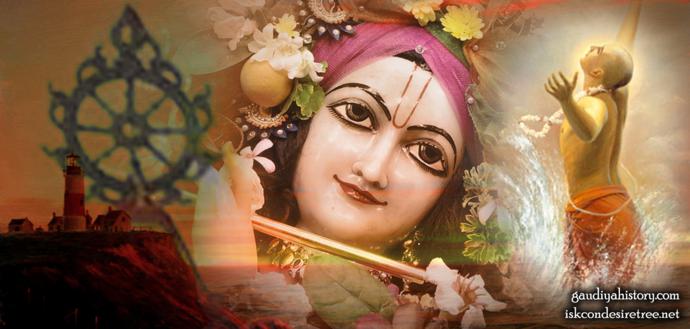
At the age of 24, Mahaprabhu left Navadwip to take sannyasa from Keshava Bharati in Katwa. From there He went to Shantipur and then on to Puri. When He arrived at Atharo Nala, a bridge with eighteen arches which marks the entrance to the town of Jagannath Puri, the Lord saw the Temple spire and had a vision of Krishna. He ran toward the Temple in a trance of love and when He entered, ran towards the Deity of Jagannath in order to embrace Him. As He came close to the altar, He fell down in a faint. The Temple watchmen and sevayats saw Him lying unconscious in the Temple, and thinking Him to be a vagrant, prepared to beat and evict Him from the Temple. (In the wallpaper: Shri Gopinath, ISKCON Chowpatty, chakra of the Shri Jagannatha Temple, Puri, Lord Shri Chaitanya).

